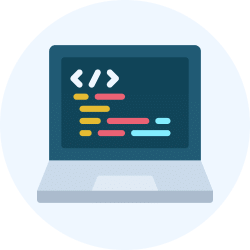Assignment: Reconnaissance and Footprinting | Ethical Hacking using Kali Linux (in English) - Software Development PDF Download
| Table of contents |

|
| Multiple Choice Questions (MCQs) |

|
| Fill in the Blanks |

|
| True/False |

|
| HOTS (Higher Order Thinking Skills) Questions |

|
| Hands-on Coding Questions |

|
Multiple Choice Questions (MCQs)
Q1: Which tool is commonly used for passive reconnaissance?
(a) whois
(b) nmap
(c) Metasploit
(d) John the Ripper
Ans: (a) whois
Q2: What does the nslookup command do?
(a) Scans open ports
(b) Queries DNS records
(c) Captures network traffic
(d) Cracks passwords
Ans: (b) Queries DNS records
Q3: Which of the following is an active reconnaissance technique?
(a) Searching for emails on Google
(b) Running an nmap scan on the target
(c) Looking up domain registration information
(d) Checking LinkedIn for employee details
Ans: (b) Running an nmap scan on the target
Q4: Which command is used to discover subdomains of a target website?
(a) dig
(b) sublist3r
(c) ifconfig
(d) hydra
Ans: (b) sublist3r
Q5: What is the purpose of the theHarvester tool?
(a) Brute force login attempts
(b) Gather email addresses and domain info
(c) Scan for vulnerabilities
(d) Encrypt data
Ans: (b) Gather email addresses and domain info
Q6: What type of reconnaissance involves directly interacting with the target system?
(a) Passive reconnaissance
(b) Active reconnaissance
(c) Social engineering
(d) Spear phishing
Ans: (b) Active reconnaissance
Q7: Which command can be used to perform a DNS zone transfer?
(a) nslookup -type=AXFR
(b) whois
(c) netstat -an
(d) traceroute
Ans: (a) nslookup -type=AXFR
Q8: What tool is used to trace the route packets take to reach a target?
(a) traceroute
(b) dig
(c) nmap
(d) john
Ans: (a) traceroute
Q9: How can you extract metadata from a document?
(a) strings
(b) exiftool
(c) airmon-ng
(d) hping3
Ans: (b) exiftool
Q10: Which of the following techniques is considered passive footprinting?
(a) Port scanning
(b) Social media research
(c) Exploiting a web server
(d) Sending phishing emails
Ans: (b) Social media research
Fill in the Blanks
Q1: The command ________ is used to perform a traceroute in Linux.
Ans: traceroute
Q2: The tool ________ is used to extract metadata from files.
Ans: exiftool
Q3: Passive reconnaissance involves gathering information without directly interacting with the ________.
Ans: target system
Q4: The ________ command in Linux is used to check domain name system (DNS) records.
Ans: dig
Q5: An example of active reconnaissance is running a ________ scan on a target.
Ans: nmap
True/False
1. Whois lookup provides information about the owner of a domain.
Ans: True
2. Passive reconnaissance involves scanning a target's open ports.
Ans: False
3. TheHarvester is a tool used for discovering emails and subdomains.
Ans: True
4. DNS zone transfers are a passive reconnaissance method.
Ans: False
5. Traceroute helps in mapping the path packets take across networks.
Ans: True
 |
Download the notes
Assignment: Reconnaissance and Footprinting
|
Download as PDF |
HOTS (Higher Order Thinking Skills) Questions
Q1: You are hired by a company to gather information about their online presence without directly interacting with their systems. What tools and techniques would you use?
Ans: Use whois, theHarvester, Google Dorking, shodan, and social media analysis.
Q2: While conducting a security assessment, you suspect that a company’s DNS server allows unauthorized zone transfers. How would you confirm this, and what are the risks?
Ans: Use nslookup -type=AXFR target.com to test for zone transfer vulnerability. If successful, attackers can gain detailed DNS records, revealing the internal network structure.
Q3: A financial organization wants to ensure that their sensitive documents do not contain hidden metadata before publication. How would you verify and remove metadata from their files?
Ans: Use exiftool document.pdf to check for metadata and exiftool -all= document.pdf to remove it.
Q4: During an engagement, you need to find all subdomains of a target organization to check for exposed services. What tool and command would you use, and why is this important?
Ans: Use Sublist3r -d target.com. Finding subdomains helps identify forgotten or misconfigured services that could be exploited.
Q5: Your client wants to understand what technologies their competitors use on their websites without directly interacting with them. What tool would you recommend, and how would you use it?
Ans: Use whatweb target.com or builtwith.com to passively analyze the technology stack of a competitor’s website.
Hands-on Coding Questions
Q1: Write a Python script that extracts email addresses from a given webpage using regex.
Ans:
import re
import requests
url = "https://example.com"
response = requests.get(url)
emails = re.findall(r"[a-zA-Z0-9._%+-]+@[a-zA-Z0-9.-]+\.[a-zA-Z]{2,}", response.text)
print("Extracted Emails:", emails)
Q2: Create a Bash script that performs a whois lookup on a list of domains from a file.
Ans:
#!/bin/bash
while read domain; do
echo "Performing whois lookup for: $domain"
whois $domain
echo "--------------------------------"
done < domains.txt
|
95 videos|6 docs
|
FAQs on Assignment: Reconnaissance and Footprinting - Ethical Hacking using Kali Linux (in English) - Software Development
| 1. What is ethical hacking and how does it differ from malicious hacking? |  |
| 2. What are some common tools used in ethical hacking? |  |
| 3. What are the key phases of the ethical hacking process? |  |
| 4. Why is it important for organizations to conduct ethical hacking? |  |
| 5. What are the legal implications of ethical hacking? |  |































